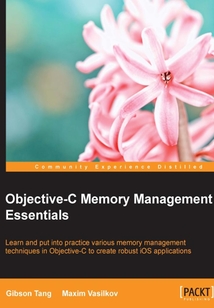首頁(yè) > 計(jì)算機(jī)網(wǎng)絡(luò) >
編程語(yǔ)言與程序設(shè)計(jì)
> Objective-C Memory Management Essentials最新章節(jié)目錄
舉報(bào) 

會(huì)員
Objective-C Memory Management Essentials
最新章節(jié):
Index
IfyouarenewtoObjective-CoraveteraniniOSapplicationdevelopment,thisisthebookforyou.Thisbookwillensurethatyoucanactivelylearnthemethodsandconceptsinrelationtomemorymanagementinamoreengagingway.BasicknowledgeofiOSdevelopmentisrequiredforthisbook.
目錄(99章)
倒序
- coverpage
- Objective-C Memory Management Essentials
- Credits
- About the Authors
- About the Reviewers
- www.PacktPub.com
- Support files eBooks discount offers and more
- Preface
- What this book covers
- What you need for this book
- Who this book is for
- Conventions
- Reader feedback
- Customer support
- Chapter 1. Introduction to Objective-C Memory Management
- Why do we need memory management in Objective-C?
- An object's ownership and life cycle
- Ownership of object and reference counting
- What's a memory leak and why pay attention to it?
- What is an object within Objective-C?
- Summary
- Chapter 2. Automatic Reference Counting
- What is ARC and how does it work?
- How ARC looks
- Project settings for ARC
- A memory model in Objective-C
- What you need to know about ARC and weak references
- Summary
- Chapter 3. Using Autorelease Pools
- Understanding the autorelease pool mechanism
- Autorelease pool mechanism
- An overview of Apple autoreleased classes
- ARC and autorelease
- Autorelease pool blocks and threads
- Summary
- Chapter 4. Object Creation and Storage
- Creation and initialization of objects
- What is a class?
- Object immutability
- Object mutability
- Inheritance
- Convenience initializers
- An Objective-C programmer's responsibility
- The singleton pattern
- Creating @property
- Creating custom methods
- String formatting
- Summary
- Chapter 5. Managing Your Application Data
- Device memory
- Caching
- SQLite
- Summary
- Chapter 6. Using Core Data for Persistence
- Why use Core Data?
- Understanding Core Data concepts
- Putting it into practice
- Getting into the code
- Saving data into the persistent store
- Deleting data from the persistent store
- Updating data
- Summary
- Chapter 7. Key-value Programming Approaches
- What is key-value coding or KVC?
- The NSKeyValueCoding protocol
- Manual subsets of NSKeyValueCoding behavior
- Associated objects
- Selectors as keys
- Maximum flexibility and handling unusual keys/values
- Key-value observing
- Summary
- Chapter 8. Introduction to Swift
- Welcome to Swift
- Basics of Swift
- Memory management in Swift
- Summary
- Chapter 9. Memory Management and Debugging
- Memory leaks
- Using the debugger and breakpoints
- Collecting data on your app
- Plumbing memory leaks
- Using the LLVM / Clang Static Analyzer
- Summary
- Chapter 10. Tips and Tricks for Memory Management
- Objective-C C and memory management
- Getters and setters
- The property attribute in Objective-C
- Performance guidelines
- Don't overthink about memory management
- When to avoid KVC and KVO
- Summary
- Chapter 11. Features of Xcode 6
- Introducing Xcode 6
- What's new in storyboard
- Debugging in Xcode 6
- What's new in Interface Builder
- Playground for Swift
- Summary
- Index 更新時(shí)間:2021-07-23 20:09:30
推薦閱讀
- OpenShift開發(fā)指南(原書第2版)
- Visual Basic程序開發(fā)(學(xué)習(xí)筆記)
- 趣學(xué)Python算法100例
- Java Web及其框架技術(shù)
- 深入淺出RxJS
- Android Native Development Kit Cookbook
- 劍指MySQL:架構(gòu)、調(diào)優(yōu)與運(yùn)維
- Java系統(tǒng)化項(xiàng)目開發(fā)教程
- 移動(dòng)互聯(lián)網(wǎng)軟件開發(fā)實(shí)驗(yàn)指導(dǎo)
- 零基礎(chǔ)學(xué)HTML+CSS
- Julia High Performance(Second Edition)
- Mastering Embedded Linux Programming
- Node.js 6.x Blueprints
- Apache Solr for Indexing Data
- Django 2.0 入門與實(shí)踐
- Learning PowerShell DSC(Second Edition)
- Swift語(yǔ)言實(shí)戰(zhàn)晉級(jí)(第2版)
- Java Web應(yīng)用設(shè)計(jì)及實(shí)戰(zhàn)
- Python機(jī)器學(xué)習(xí)核心算法編程實(shí)例
- Julia設(shè)計(jì)模式
- Java語(yǔ)言程序設(shè)計(jì)
- Learning IPython for Interactive Computing and Data Visualization
- Learning Object-Oriented Programming
- 高級(jí)前端程序員面試筆試真題庫(kù)
- UX for the Web
- INSTANT RSpec Test-Driven Development How-to
- Spring Essentials
- Beginning Data Science with Python and Jupyter
- Beginning C# 7 Hands-On:Advanced Language Features
- Mastering Machine Learning with scikit-learn(Second Edition)

